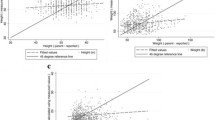Abstract
Background
There is mounting evidence that the prevalence of overweight and obesity in children is reaching epidemic proportions in North America. We compared parent-report vs. measured BMI overweight and obesity prevalence estimates among 9 year olds using the 1996 NLSCY reports published by Willms et al. (2003) and anthropometric measurements from a regional population of public school children.
Methods
Body mass index (BMI) was calculated for 1,497 9-year-old children (males N=734; females N=763) from 75 public schools in the Niagara Region of Ontario, Canada. BMI from the 1996 NLSCY was based on parental reports of height and weight of 879 nine year olds. To define overweight and obese children, we used internationally accepted age- and gender-specific cut-offs as defined by Cole et al. (2000).
Results
The NLSCY overweight prevalence estimates of boys and girls may overestimate overweight boys and girls by 17% and 10%, respectively. Measured obesity prevalence estimates were similar to parent-reports.
Conclusions
Our results suggest that parental reports of height and weight may inflate prevalence estimates of overweight children, but appear reasonably accurate for estimating obesity. Since prevalence of overweight and obesity are often combined to form a global estimate, reliance on parent-reported height and weight may overstate the magnitude of the problem.
Résumé
Contexte
Il apparaît de plus en plus que le surpoids et l’obésité chez les enfants prennent des proportions épidémiques en Amérique du Nord. Nous avons comparé les estimations de prévalence du surpoids et de l’obésité chez les enfants de 9 ans, selon les déclarations parentales et selon la mesure directe de l’indice de masse corporelle (IMC) des enfants, en nous aidant des rapports tirés de l’Enquête longitudinale nationale sur les enfants et les jeunes (ELNEJ) de 1996 publiés par Willms et coll. (2003) et des mesures anthropométriques d’une population régionale d’enfants fréquentant l’école publique.
Méthode
Nous avons calculé l’IMC de 1 497 enfants de 9 ans (734 garçons et 763 filles) fréquentant 75 écoles publiques de la région de Niagara, en Ontario (Canada). Les IMC figurant dans l’ELNEJ de 1996 étaient fondés sur les déclarations parentales de la taille et du poids de 879 enfants de 9 ans. Pour catégoriser les enfants obèses et ceux présentant un surpoids, nous avons utilisé les seuils de démarcation selon l’âge et le sexe définis par Cole et coll. (2000), qui sont internationalement acceptés.
Résultats
Les estimations de prévalence du surpoids chez les garçons et les filles selon l’ELNEJ pourraient surestimer (de 17 % chez les garçons et de 10 % chez les filles) la proportion d’enfants présentant un surpoids. Par contre, les estimations de prévalence de l’obésité tirées des mesures anthropométriques et des déclarations parentales étaient semblables.
Conclusion
Ces résultats donnent à penser que les déclarations parentales de la taille et du poids pourraient gonfler les estimations de prévalence du surpoids chez les enfants, mais que ces estimations sont raisonnablement précises pour ce qui est de l’obésité. Comme on combine souvent la prévalence du surpoids et de l’obésité pour produire une estimation globale, on risque de surestimer l’ampleur du problème si l’on se fie aux déclarations parentales de la taille et du poids.
Similar content being viewed by others
References
Villeneuve PJ, Morrison HI, Craig CL, Schaubel DE. Physical activity, physical fitness, and risk of dying. Epidemiology 1998;9:626–31.
Rowland ML. Self-reported weight and height. Am J Clin Nutr 1990;52:1125–33.
Spencer EA, Appleby PN, Davey GK, Key TJ. Validity of self-reported height and weight in 4808 EPIC-Oxford participants. Public Health Nutrition 2002;5:561–65.
Goodman E, Hinden BR, Khandelwal S. Accuracy of teen and parental reports of obesity and body mass index. Pediatrics 2000;106:52–58.
National Longitudinal Survey of Children: Overview of Survey Instruments for 1994–1995, Data Collection, Cycle I. Ottawa: Statistics Canada and Human Resources Development Canada. Cat. no 95-02.
Leger LA, Mercier D, Gadoury C, Lambert J. The multistage 20 metre shuttle run test for aerobic fitness. J Sports Sci 1988;6:93–101.
Troiano RP, Flegal KM, Kuczmarski RJ, Campbell SM, Johnson CL. Overweight prevalence and trends for children and adolescents: The National Health and Nutritional Examination Survey, 1963–1991. Arch Pediatr Adolesc Med 1995;149:1085–91.
Gilmore J. Trends and conditions in census metropolitan areas: Health of Canadians living in census metropolitan areas. Ottawa: Statistics Canada Health Statistics Division, 2004. Cat. no 89-613-MIE.
Ontario Medical Association. An ounce of prevention or a ton of trouble: Is there an epidemic of obesity in children? A position paper by the Ontario Medical Association. Ontario Medical Review 2005;32–44.
Shields M. Measured obesity: Overweight Canadian children and adolescents. Ottawa: Statistics Canada Health Statistics Division, 2005. Cat. no 82-620-MWE.
Picard A. Fattest and Fittest: St. Catharines Leads the Fat Parade. The Globe and Mail, Saturday, July 21, 2001.
Tremblay MS, Willms JD. Secular trends in the body mass index of Canadian children. CMAJ 2000;163:1429–33.
Author information
Authors and Affiliations
Corresponding author
Additional information
Acknowledgements: This study was supported by research grant # 66959 from the Canadian Institutes for Health Research (Principal Investigators: Dr. Hay & Dr. Cairney). Drs. Wade and Cairney are supported through the Canada Research Chair program by SSHRC and CIHR, respectively.
Rights and permissions
About this article
Cite this article
Banach, A., Wade, T.J., Cairney, J. et al. Comparison of Anthropometry and Parent-reported Height and Weight Among Nine Year Olds. Can J Public Health 98, 251–253 (2007). https://doi.org/10.1007/BF03405397
Received:
Accepted:
Published:
Issue Date:
DOI: https://doi.org/10.1007/BF03405397




